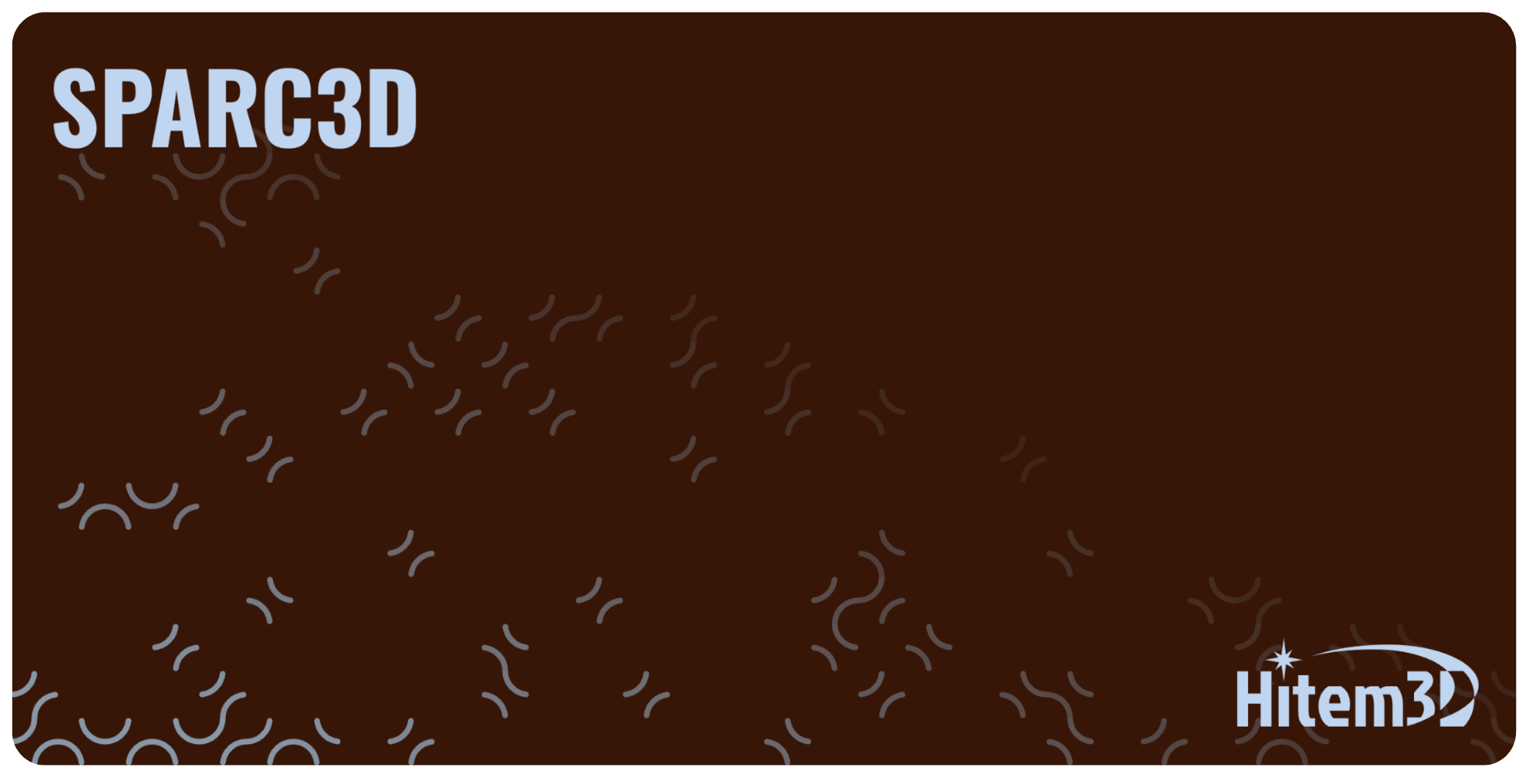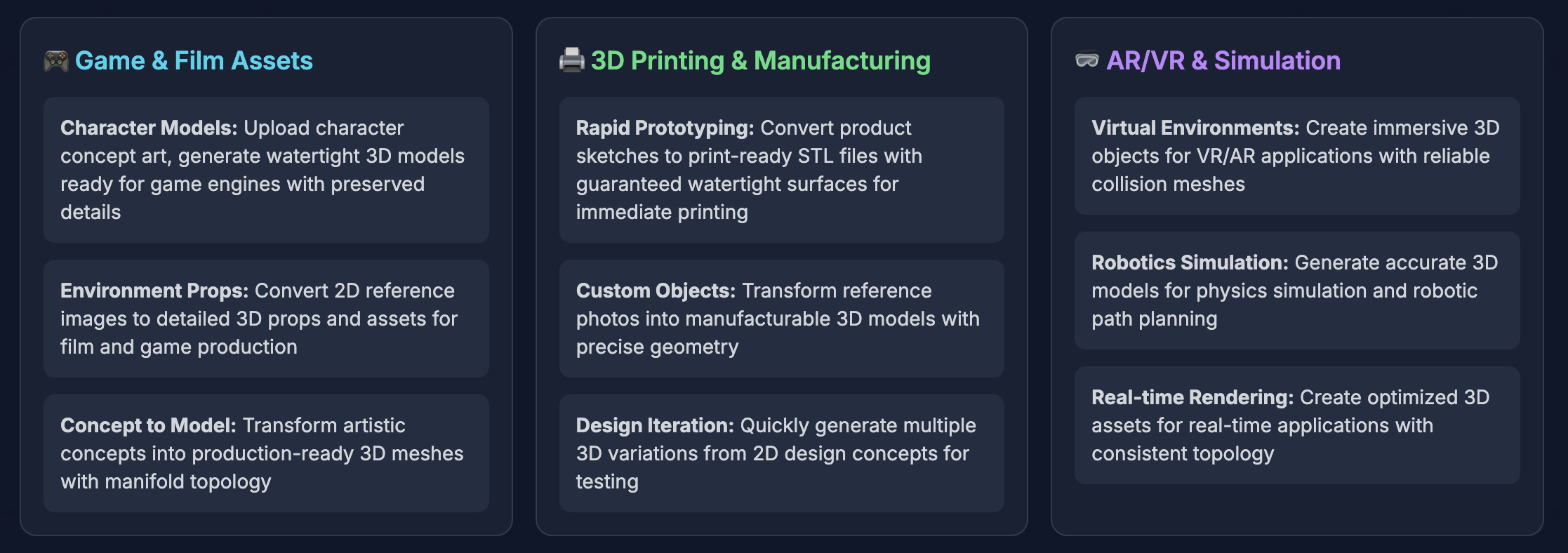
Overview
Sparc3D is a state-of-the-art 3D model generation framework developed by Math Magic and researchers from Nanyang Technological University and Imperial College London. It is designed to create high-resolution, watertight 3D models from a single 2D image, addressing many of the challenges found in traditional 3D generation pipelines.
By leveraging a novel sparse representation and a powerful variational autoencoder, Sparc3D delivers exceptional geometric detail, even for complex objects with open surfaces or intricate components.
The model is built to be both efficient and scalable, making it suitable for a wide range of applications, from game development and 3D printing to virtual and augmented reality. It also integrates seamlessly with latent diffusion models, allowing for high-resolution 3D generation with reduced inference costs.
Sparc3D is available in two version: Standard and “Portraits” (custom mode for character portraits)
This section presents the key features and generation modes available with Sparc3D on Scenario
Parameters at a Glance
Parameter | Purpose | Recommended settings |
|---|---|---|
Image(s) | Upload one image to convert it into 3D, or provide up to four images from multiple angles for higher accuracy (in order: front, back, left, right views) | - |
Resolution | Controls voxel grid size used during generation. | 512³ for previews, 1024³ for balanced quality, 1536³ for maximum detail (standard/pro) |
Face count | Specifies the maximum number of mesh polygons. | 0.5 million faces for 512³, 1 million faces for 1024³, 2 million faces for 1536³. |
Generation mode | Choose between Mesh only or Mesh + Texture | Use Mesh + Texture for most projects; choose Mesh only if you plan to texture manually |
Step‑by‑Step Guide
The following steps summarize how to use the Sparc3D model inside the Scenario web app.
Open 3D generation. From the Scenario dashboard, choose Create > 3D. The interface opens with a default model selected; click the model name and choose Sparc3D (Standard/Portrait) from the list.
Upload your image. Use one (or more) high‑resolution JPEG, PNG or WEBP file (maximum 20 MB). For best results, use clear, well-lit images that show the object from a distinct angle.
Choose the generation mode. Sparc3D supports two options:
Mesh only: Generates a watertight 3D mesh without textures. Ideal when you want to texture the model yourself.
Mesh + Texture (default): Produces a 3D mesh with color and material maps. Best for quick previews, game prototypes and 3D printing.
Set the resolution. Supported resolutions are 512³, 1024³ and 1536³ (standard/pro). Higher resolutions capture more micro‑details but take longer to generate and produce larger files.
Adjust the face count. Specify the maximum number of polygons (faces) in the mesh. Recommended ranges depend on the resolution: about 500 000 faces for 512³, 1 million faces for 1024³ and 2 million faces for 1536³. Larger face counts improve geometric fidelity but result in bigger files.
Generate the 3D model. Click Generate. Depending on the resolution and face count, generation typically completes within a few minutes. When finished, view a preview of the mesh (and textures if selected) and download the resulting model.
Resolution
a. 512³ Resolution
This is the fastest option, delivering a high-quality model with a resolution of 512x512x512 voxels. It is suitable for generating detailed assets with a recommended polygon count of around 500,000 faces. This resolution is ideal for prototyping game assets and general-purpose 3D modeling.
b. 1024³ Resolution (Default)
This is the default resolution, offering an excellent balance of detail and performance. With a resolution of 1024x1024x1024 voxels and a recommended polygon count of 1,000,000 faces, this mode creates high-fidelity models with intricate geometric details. It is well-suited for crafting hero assets, detailed product visualizations, and high-quality 3D printing.
c. 1536³ Resolution (standard/pro)
This is the highest resolution available, providing the maximum level of geometric fidelity. With a resolution of 1536x1536x1536 voxels and a recommended polygon count of 2,000,000 faces, this mode is designed for professional use cases where the utmost detail is required. It is ideal high-end architectural visualization, and other applications that demand the highest quality.
Polygon Count (Face)
Sparc3D allows you to customize the polygon count of the generated mesh, giving you control over the level of detail and the performance of the model. The polygon count can be set within a range of 100,000 to 2,000,000 faces. The recommended polygon count varies depending on the selected resolution:
512³ Resolution: 500,000 faces
1024³ Resolution: 1,000,000 faces
1536³ Resolution: 2,000,000 faces
Higher polygon counts will result in more detailed models but may also increase file size and processing time. Lower polygon counts are suitable for real-time applications and mobile devices, while higher counts are better for high-fidelity rendering and 3D printing.
Technical Advantages
Sparc3D introduces several key improvements that make it better than traditional 3D generation methods:
Smart Mesh Processing (Sparcubes)
The Sparcubes representation is a novel approach to converting raw meshes into watertight surfaces. Unlike traditional methods that often suffer from resolution degradation and missing geometry, Sparcubes preserves fine details and small components while achieving a 3× speedup over previous methods. The process involves four key steps: active voxel extraction, flood fill for sign labeling, gradient-based deformation optimization, and rendering refinement.
Efficient Learning System (Sparconv-VAE)
Sparconv-VAE is the first variational autoencoder built entirely on sparse convolutional networks. This eliminates the modality gap that exists in traditional methods, where different data representations must be converted between each other. By maintaining consistency throughout the process, Sparconv-VAE achieves near-lossless 3D reconstruction with significantly reduced training time (4× faster convergence compared to previous methods).
Complete, Printable Models
One of the most significant advantages of Sparc3D is its ability to generate watertight meshes from any input, including open surfaces and disconnected components. This makes the generated models suitable for 3D printing and other applications that require closed surfaces.
Use Cases
Sparc3D is well suited for quickly converting AI‑generated concept art or product designs into printable or game‑ready 3D assets. It has been used in fields such as 3D printing, industrial design, game development and film production. However, the resulting models may need manual clean‑up (decimation, retopology and UV unwrapping) before integration into production pipelines.
Game Development
Generate detailed 3D assets from concept art or reference images. The watertight meshes and optimized polygon counts make the models suitable for real-time rendering in game engines.
3D Printing
The watertight nature of Sparc3D-generated models makes them ideal for 3D printing. The high level of detail preservation ensures that intricate features are maintained in the physical print.
Virtual and Augmented Reality
Create immersive 3D content for VR and AR applications. The multiple resolution options allow you to balance quality and performance based on the target platform.
Film and Animation
Generate high-fidelity 3D models for use in film production and animation. The ultra-high resolution option (1536³) provides the level of detail required for close-up shots and hero assets.
Product Visualization
Convert product photos into 3D models for e-commerce, marketing, and design visualization. The ability to generate both geometry and textures from a single image streamlines the content creation process.
Industrial Design
Rapidly prototype and visualize design concepts by converting sketches or reference images into 3D models. The fast generation times make it suitable for iterative design workflows.

Best Practices
Prepare quality input
Clean backgrounds: Removing the background helps the model focus on the subject and reduces unwanted geometry.
High‑resolution images: Upscaling your reference image often improves the resulting texture quality.
Clear object boundaries and consistent lighting: Images with well‑defined edges, consistent lighting and a single prominent subject yield better reconstruction.
Simple views: For characters or objects, front‑facing or side‑facing images work best. If the object has limbs, a neutral pose (such as a T‑pose) prevents fused geometry.
Optimize parameters
Begin with default resolution (1024³), face count (one million) and guidance (around six). Generate a test model, then adjust one setting at a time. Increasing face count without increasing steps can produce poorly formed meshes, so always balance these parameters.
References
[1] Li, Z., Wang, Y., Zheng, H., Luo, Y., & Wen, B. (2025). Sparc3D: Sparse Representation and Construction for High-Resolution 3D Shapes Modeling. arXiv preprint arXiv:2505.14521. https://arxiv.org/abs/2505.14521
[2] Official Sparc3D Project Website. https://lizhihao6.github.io/Sparc3D/
[3] Sparc3D GitHub Repository. https://github.com/lizhihao6/Sparc3D
Was this helpful?